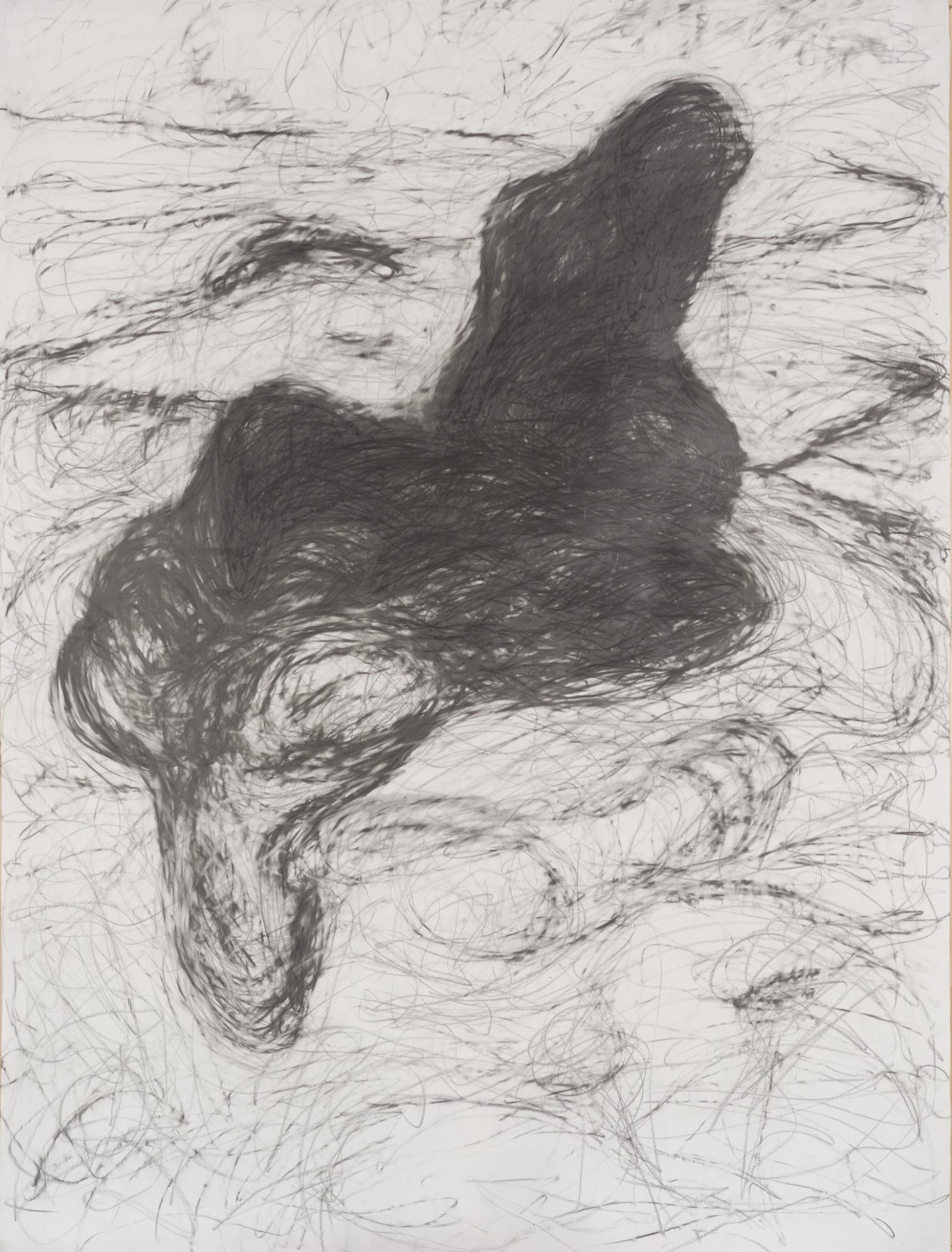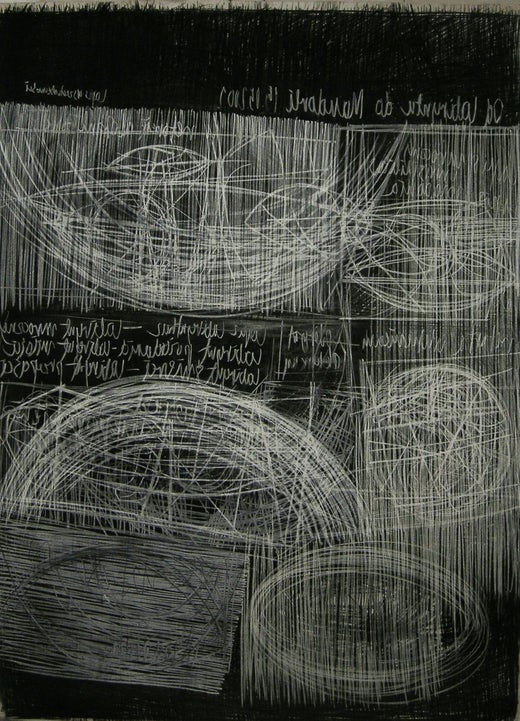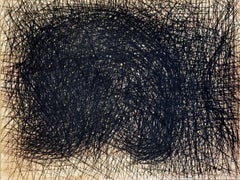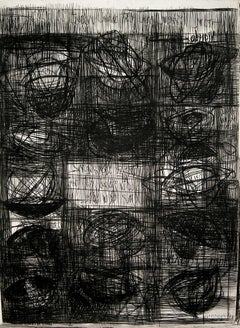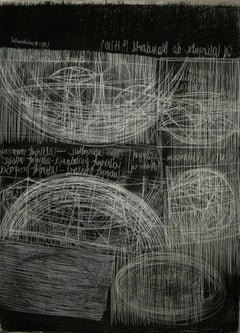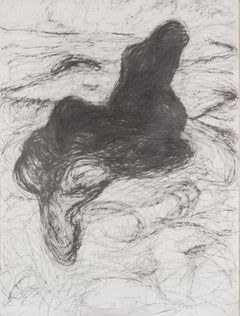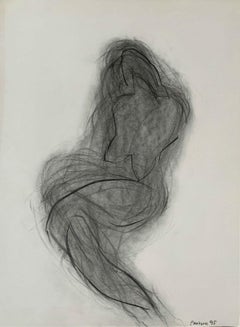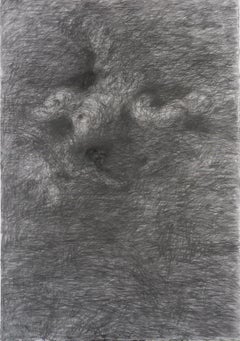Items Similar to Mandorla - Large Format Charcoal On Paper, Black White Drawing
Want more images or videos?
Request additional images or videos from the seller
1 of 3
Krzysztof GliszczyńskiMandorla - Large Format Charcoal On Paper, Black White Drawing2000
2000
$2,993.20
£2,226.91
€2,500
CA$4,170.15
A$4,538.70
CHF 2,382.78
MX$54,834.11
NOK 29,906.47
SEK 28,198.27
DKK 19,035.52
About the Item
Krzysztof Gliszczyński is Professor for painting on Academy of fine arts Gdansk.
The artwork is unframed and will be shipped rolled in a tube
Artist Statement
In the 1990s I started collecting flakes of paint – leftovers from my work. I would put fresh ones in wooden formworks, dried ones in glass containers. They constituted layers of investigations into the field of painting, enclosed in dated and numbered cuboids measuring 47 × 10.5 × 10.5 cm. I called those objects Urns. In 2016, I displayed them at an exhibition, moulding a single object out of all the Urns. The Urns inspired me to redefine the status of my work as a painter. In order to do it, I performed a daunting task of placing the layers of paint not in an urn, but on a canvas, pressing each fresh bit of paint with my thumb. In the cycle of paintings Autoportret a’retour, the matter was transferred from painting to painting, expanding the area of each consecutive one. Together, the bits, the residua of paint, kept alive the memory of the previous works. It was a stage of the atomization of the painting matter and its alienation from the traditional concepts and aesthetic relations. Thus, the cycle of synergic paintings was created, as I called them, guided by the feeling evoked in me by the mutually intensifying flakes of paint. The final aesthetic result of the refining of the digested matter was a consequence of the automatism of the process of layering, thumb-pressing, and scraping off again. Just like in an archaeological excavation, attempts are made to unite and retrieve that which has been lost. This avant-garde concept consists in transferring into the area of painting of matter, virtually degraded and not belonging to the realm of art. And yet the matter re-enters it, acquiring a new meaning. The matter I created, building up like lava, became my new technique. I called it perpetuum pictura – self-perpetuated painting. Alchemical concepts allowed me to identify the process inherent in the emerging matter, to give it direction and meaning. In a way, I created matter which was introducing me into the pre-symbolic world – a world before form, unnamed. From this painterly magma, ideas sprung up, old theories of colour and the convoluted problem of squaring the circle manifested themselves again. Just like Harriot’s crystal refracted light in 1605, I tried to break up colour in the painting Iosis. Paintings were becoming symptoms, like in the work Pulp fiction, which at that time was a gesture of total fragmentation of matter and of transcending its boundaries, my dialogue with the works of Jackson Pollock and the freedom brought by his art. The painting Geometrica de physiologiam pictura contains a diagram in which I enter four colours that constitute an introduction to protopsychology, alchemical transmutation, and the ancient theory of colour. It this work I managed to present the identification of the essence of human physiology with art. But the essential aspect of my considerations in my most recent paintings is the analysis of abstraction, the study of its significance for the contemporary language of art and the search for the possibilities of creating a new message. For me, abstraction is not an end in itself, catering to the largely predicable expectations of the viewers. To study the boundary between visibility and invisibility, like in the work Unsichtbar, is to ask about the status of the possibilities of the language of abstraction. The moment of fluidity which I am able to attain results from the matter – matter which contains only a memory of the previous works, and yet becomes the reason for seeking balance between the deepest layers of the psyche, which are never static, but forever subject to changes. Its counterweight is geometry, which represents rationality and has the ability to organize and define artistic form, like in the work Memory. By going back to the works of El Greco and his painting Toledo, I was able to once more study the force of the idea of light, which gave the painting its form and the apocalyptic atmosphere contained therein. El Greco, rediscovered by Paul Cézanne, made an enormous contribution to the creation of the foundations of modern painting. El Greco’s idea inspired me to paint Toledo.
In the work Anamnesis, I tackle the idea of memory and its opposite, oblivion, which, in the creative process, allows to deconstruct the rationality of memory. History of the Painter from Borowy Młyn is an installation which speaks of the process of painting, the act of creation, and refers to the story of my father, a house painter, and his traumatic experiences after being separated from his family by the Nazis in 1944. Rolling scrolls from strips of canvases became a symbolic act of dressing a wound. The scrolls were rolled onto a metal frame up until the moment when the burden became too much to bear.
Krzysztof Gliszczyński is Professor for painting on Academy of fine arts Gdansk.
Krzysztof Gliszczyński born in Miastko in 1962. Graduated from the Gdańsk Academy of Fine Arts in 1987 in the studio of Prof. Kazimierz Ostrowski. Between 1995 and 2002 founder and co-manager of Koło Gallery in Gdańsk. lnitiator of the Kazimierz Ostrowski Award, con-ferred by the Union of Polish Artists and Designers (ZPAP), Gdańsk Chapter. Dean of the Painting Faculty of the Gdańsk Academy of Fine Arts in the years 2008-2012. Vice Rector for Development and Cooperation of the Gdańsk Academy of Fine Arts in the years 2012-2016. Obtained a professorship in 2011. Currently head of the Third Painting Studio of the Painting Faculty of the Gdańsk Academy of Fine Arts. He has taken part in a few dozen exhibitions in Poland and abroad. He has received countless prizes and awards for his artistic work. He is active in the field of painting, drawing, objects, and video.
- Creator:Krzysztof Gliszczyński (1962, Polish)
- Creation Year:2000
- Dimensions:Height: 78.75 in (200 cm)Width: 59.06 in (150 cm)
- Medium:
- Movement & Style:
- Period:
- Condition:
- Gallery Location:Salzburg, AT
- Reference Number:1stDibs: LU1035312270812
Krzysztof Gliszczyński
Krzysztof Gliszczyński is Professor for painting on Academy of fine arts Gdansk. Krzysztof Gliszczyński born in Miastko in 1962. Graduated from the Gdańsk Academy of Fine Arts in 1987 in the studio of Prof. Kazimierz Ostrowski. Between 1995 and 2002 founder and co-manager of Koło Gallery in Gdańsk. lnitiator of the Kazimierz Ostrowski Award, con-ferred by the Union of Polish Artists and Designers (ZPAP), Gdańsk Chapter. Dean of the Painting Faculty of the Gdańsk Academy of Fine Arts in the years 2008-2012. Vice Rector for Development and Cooperation of the Gdańsk Academy of Fine Arts in the years 2012-2016. Obtained a professorship in 2011. Currently head of the Third Painting Studio of the Painting Faculty of the Gdańsk Academy of Fine Arts. He has taken part in a few dozen exhibitions in Poland and abroad. He has received countless prizes and awards for his artistic work. He is active in the field of painting, drawing, objects, and video.
About the Seller
5.0
Gold Seller
Premium sellers maintaining a 4.3+ rating and 24-hour response times
Established in 2005
1stDibs seller since 2018
156 sales on 1stDibs
Typical response time: 2 hours
- ShippingRetrieving quote...Shipping from: Sopot, Poland
- Return Policy
Authenticity Guarantee
In the unlikely event there’s an issue with an item’s authenticity, contact us within 1 year for a full refund. DetailsMoney-Back Guarantee
If your item is not as described, is damaged in transit, or does not arrive, contact us within 7 days for a full refund. Details24-Hour Cancellation
You have a 24-hour grace period in which to reconsider your purchase, with no questions asked.Vetted Professional Sellers
Our world-class sellers must adhere to strict standards for service and quality, maintaining the integrity of our listings.Price-Match Guarantee
If you find that a seller listed the same item for a lower price elsewhere, we’ll match it.Trusted Global Delivery
Our best-in-class carrier network provides specialized shipping options worldwide, including custom delivery.More From This Seller
View AllUntitled 1 - Expressive Charcoal On Paper Painting, Black White Drawing
By Krzysztof Gliszczyński
Located in Salzburg, AT
The paper of the work is not yellowed, there is a applied yellowed primer under the drawing
Krzysztof Gliszczyński is Professor for painting o...
Category
Early 2000s Conceptual Abstract Drawings and Watercolors
Materials
Paper, Charcoal
Drawing 13, Series Drawing - Large Format, Charcoal On Paper Panting
By Krzysztof Gliszczyński
Located in Salzburg, AT
The artwork is unframed and will be shipped rolled in a tube
Krzysztof Gliszczyński is Professor for painting on Academy of fine arts Gdansk. ...
Category
Early 2000s Conceptual Figurative Drawings and Watercolors
Materials
Paper, Charcoal
Drawing 14, Series Drawing - Large Format, Charcoal On Paper Panting
By Krzysztof Gliszczyński
Located in Salzburg, AT
The artwork is unframed and will be shipped rolled in a tube
Krzysztof Gliszczyński is Professor for painting on Academy of fine arts Gdansk.
Krzysztof Gliszczyński born in Miastko in 1962. Graduated from the Gdańsk Academy of Fine Arts in 1987 in the studio of Prof. Kazimierz Ostrowski. Between 1995 and 2002 founder and co-manager of Koło Gallery in Gdańsk. lnitiator of the Kazimierz Ostrowski Award, con-ferred by the Union of Polish Artists and Designers (ZPAP), Gdańsk Chapter. Dean of the Painting Faculty of the Gdańsk Academy of Fine Arts in the years 2008-2012. Vice Rector for Development and Cooperation of the Gdańsk Academy of Fine Arts in the years 2012-2016. Obtained a professorship in 2011. Currently head of the Third Painting Studio of the Painting Faculty of the Gdańsk Academy of Fine Arts. He has taken part in a few dozen exhibitions in Poland and abroad. He has received countless prizes and awards for his artistic work. He is active in the field of painting, drawing, objects, and video.
Artist Statement
In the 1990s I started collecting flakes of paint – leftovers from my work. I would put fresh ones in wooden formworks, dried ones in glass containers. They constituted layers of investigations into the field of painting, enclosed in dated and numbered cuboids measuring 47 × 10.5 × 10.5 cm. I called those objects Urns. In 2016, I displayed them at an exhibition, moulding a single object out of all the Urns. The Urns inspired me to redefine the status of my work as a painter. In order to do it, I performed a daunting task of placing the layers of paint not in an urn, but on a canvas, pressing each fresh bit of paint with my thumb. In the cycle of paintings Autoportret a’retour, the matter was transferred from painting to painting, expanding the area of each consecutive one. Together, the bits, the residua of paint, kept alive the memory of the previous works. It was a stage of the atomization of the painting matter and its alienation from the traditional concepts and aesthetic relations. Thus, the cycle of synergic paintings was created, as I called them, guided by the feeling evoked in me by the mutually intensifying flakes of paint. The final aesthetic result of the refining of the digested matter was a consequence of the automatism of the process of layering, thumb-pressing, and scraping off again. Just like in an archaeological excavation, attempts are made to unite and retrieve that which has been lost. This avant-garde concept consists in transferring into the area of painting of matter, virtually degraded and not belonging to the realm of art. And yet the matter re-enters it, acquiring a new meaning. The matter I created, building up like lava, became my new technique. I called it perpetuum pictura – self-perpetuated painting. Alchemical concepts allowed me to identify the process inherent in the emerging matter, to give it direction and meaning. In a way, I created matter which was introducing me into the pre-symbolic world – a world before form, unnamed. From this painterly magma, ideas sprung up, old theories of colour and the convoluted problem of squaring the circle manifested themselves again. Just like Harriot’s crystal refracted light in 1605, I tried to break up colour in the painting Iosis. Paintings were becoming symptoms, like in the work Pulp fiction, which at that time was a gesture of total fragmentation of matter and of transcending its boundaries, my dialogue with the works of Jackson Pollock and the freedom brought by his art. The painting Geometrica de physiologiam pictura contains a diagram in which I enter four colours that constitute an introduction to protopsychology, alchemical transmutation, and the ancient theory of colour. It this work I managed to present the identification of the essence of human physiology with art. But the essential aspect of my considerations in my most recent paintings is the analysis of abstraction, the study of its significance for the contemporary language of art and the search for the possibilities of creating a new message. For me, abstraction is not an end in itself, catering to the largely predicable expectations of the viewers. To study the boundary between visibility and invisibility, like in the work Unsichtbar, is to ask about the status of the possibilities of the language of abstraction. The moment of fluidity which I am able to attain results from the matter – matter...
Category
Early 2000s Conceptual Figurative Drawings and Watercolors
Materials
Paper, Charcoal
TWO SPACES - Expressive Charcoal On Paper Painting, Black White Drawing
By Krzysztof Gliszczyński
Located in Salzburg, AT
The work is on 1 paper.
Krzysztof Gliszczyński is Professor for painting on Academy of fine arts Gdansk.
The artwork is unframed and will be...
Category
Early 2000s Conceptual Abstract Drawings and Watercolors
Materials
Paper, Charcoal
Light, Series Drawing From Israel - Large Format, Charcoal On Paper
By Krzysztof Gliszczyński
Located in Salzburg, AT
The artwork is unframed and will be shipped rolled in a tube
Krzysztof Gliszczyński is Professor for painting on Academy of fine arts Gdansk.
Krzysztof Gliszczyński born in Miastko in 1962. Graduated from the Gdańsk Academy of Fine Arts in 1987 in the studio of Prof. Kazimierz Ostrowski. Between 1995 and 2002 founder and co-manager of Koło Gallery in Gdańsk. lnitiator of the Kazimierz Ostrowski Award, con-ferred by the Union of Polish Artists and Designers (ZPAP), Gdańsk Chapter. Dean of the Painting Faculty of the Gdańsk Academy of Fine Arts in the years 2008-2012. Vice Rector for Development and Cooperation of the Gdańsk Academy of Fine Arts in the years 2012-2016. Obtained a professorship in 2011. Currently head of the Third Painting Studio of the Painting Faculty of the Gdańsk Academy of Fine Arts. He has taken part in a few dozen exhibitions in Poland and abroad. He has received countless prizes and awards for his artistic work. He is active in the field of painting, drawing, objects, and video.
Artist Statement
In the 1990s I started collecting flakes of paint – leftovers from my work. I would put fresh ones in wooden formworks, dried ones in glass containers. They constituted layers of investigations into the field of painting, enclosed in dated and numbered cuboids measuring 47 × 10.5 × 10.5 cm. I called those objects Urns. In 2016, I displayed them at an exhibition, moulding a single object out of all the Urns. The Urns inspired me to redefine the status of my work as a painter. In order to do it, I performed a daunting task of placing the layers of paint not in an urn, but on a canvas, pressing each fresh bit of paint with my thumb. In the cycle of paintings Autoportret a’retour, the matter was transferred from painting to painting, expanding the area of each consecutive one. Together, the bits, the residua of paint, kept alive the memory of the previous works. It was a stage of the atomization of the painting matter and its alienation from the traditional concepts and aesthetic relations. Thus, the cycle of synergic paintings was created, as I called them, guided by the feeling evoked in me by the mutually intensifying flakes of paint. The final aesthetic result of the refining of the digested matter was a consequence of the automatism of the process of layering, thumb-pressing, and scraping off again. Just like in an archaeological excavation, attempts are made to unite and retrieve that which has been lost. This avant-garde concept consists in transferring into the area of painting of matter, virtually degraded and not belonging to the realm of art. And yet the matter re-enters it, acquiring a new meaning. The matter I created, building up like lava, became my new technique. I called it perpetuum pictura – self-perpetuated painting. Alchemical concepts allowed me to identify the process inherent in the emerging matter, to give it direction and meaning. In a way, I created matter which was introducing me into the pre-symbolic world – a world before form, unnamed. From this painterly magma, ideas sprung up, old theories of colour and the convoluted problem of squaring the circle manifested themselves again. Just like Harriot’s crystal refracted light in 1605, I tried to break up colour in the painting Iosis. Paintings were becoming symptoms, like in the work Pulp fiction, which at that time was a gesture of total fragmentation of matter and of transcending its boundaries, my dialogue with the works of Jackson Pollock and the freedom brought by his art. The painting Geometrica de physiologiam pictura contains a diagram in which I enter four colours that constitute an introduction to protopsychology, alchemical transmutation, and the ancient theory of colour. It this work I managed to present the identification of the essence of human physiology with art. But the essential aspect of my considerations in my most recent paintings is the analysis of abstraction, the study of its significance for the contemporary language of art and the search for the possibilities of creating a new message. For me, abstraction is not an end in itself, catering to the largely predicable expectations of the viewers. To study the boundary between visibility and invisibility, like in the work Unsichtbar, is to ask about the status of the possibilities of the language of abstraction. The moment of fluidity which I am able to attain results from the matter – matter...
Category
Early 2000s Conceptual Abstract Drawings and Watercolors
Materials
Paper, Charcoal
Phantasmagoria - Contemporary Figurative Ink Painting, New Expression
Located in Salzburg, AT
Grażyna Rigall is a painter, illustrator, author of stage designs and music videos. - The artist is interested in the merging of the world of fauna and ...
Category
2010s Contemporary Figurative Paintings
Materials
Paper, Ink
You May Also Like
Untitled - 21st Century, Black, Monochrome, Abstract Drawing, Organic, Tactile
By Zsolt Berszán
Located in Baden-Baden, DE
Untitled, 2016
Black glue on paper (Signed on reverse)
78 7/10 H × 59 1/10 W in
200 H × 150 W cm
Berszán depicts in his works the primary turmoil where the violence of the unbinding...
Category
2010s Abstract Abstract Drawings and Watercolors
Materials
Paper, Glue
Untitled 01 - Abstract Art, Drawing, Organic, Contemporary, Graphite, Gray
By Zsolt Berszán
Located in Baden-Baden, DE
Untitled 01, 2016
Graphite on paper (Signed on reverse)
77.95 H x 58.66 W in
198 H x 149 W cm
Zsolt Berszán’s work speaks of repulsion and fascination a...
Category
2010s Abstract Abstract Drawings and Watercolors
Materials
Paper, Graphite
Untitled - Contemporary pencil drawing, Figurative, Black & white
By Antoni Janusz Pastwa
Located in Warsaw, PL
ANTONI JANUSZ PASTWA (b. 1944)
Graduated from Academy of Fine Arts in Warsaw at the Faculty of Sculpture. Obtained his diploma in 1970. Between 1974-1981 he was an assistant at profe...
Category
2010s Abstract Figurative Drawings and Watercolors
Materials
Paper, Pencil
Untitled 02 - Contemporary Art, Abstract, Drawing on Canvas, Grey, Monochrome
By Zsolt Berszán
Located in Baden-Baden, DE
Untitled 02 (Remains of the Remains), 2021
Graphite on canvas
78 37/50 H x 55 6/50 W in.
200 H x 140 W cm
The new series of large-sized paintings, signed by Zsolt Berszán, created i...
Category
2010s Abstract Abstract Drawings and Watercolors
Materials
Canvas, Graphite
Untitled - Contemporary pencil drawing, Figurative, Black & white
By Antoni Janusz Pastwa
Located in Warsaw, PL
ANTONI JANUSZ PASTWA (b. 1944)
Graduated from Academy of Fine Arts in Warsaw at the Faculty of Sculpture. Obtained his diploma in 1970. Between 1974-1981 he was an assistant at profe...
Category
2010s Abstract Figurative Drawings and Watercolors
Materials
Paper, Pencil
Untitled - Contemporary pencil drawing, Figurative, Black & white
By Antoni Janusz Pastwa
Located in Warsaw, PL
ANTONI JANUSZ PASTWA (b. 1944)
Graduated from Academy of Fine Arts in Warsaw at the Faculty of Sculpture. Obtained his diploma in 1970. Between 1974-1981 he was an assistant at profe...
Category
2010s Abstract Figurative Drawings and Watercolors
Materials
Paper, Pencil
More Ways To Browse
Black And White Charcoal Abstract Drawing
El Greco
Pulp Fiction
Large Charcoal Drawing
Krzysztof Gliszczynski
Shaker El Maadawy
Joan Miro Drawing
Susan Weil
Cubism Paintings Drawings
Russian Empire Painting
Anita Steckel
Balloon Drawing
Fernando Jorge
Jenkins Watercolor Paul
Joyce Miller
Paul Jenkins Watercolor Paper
Alcohol Ink Painting
Clark Walker





